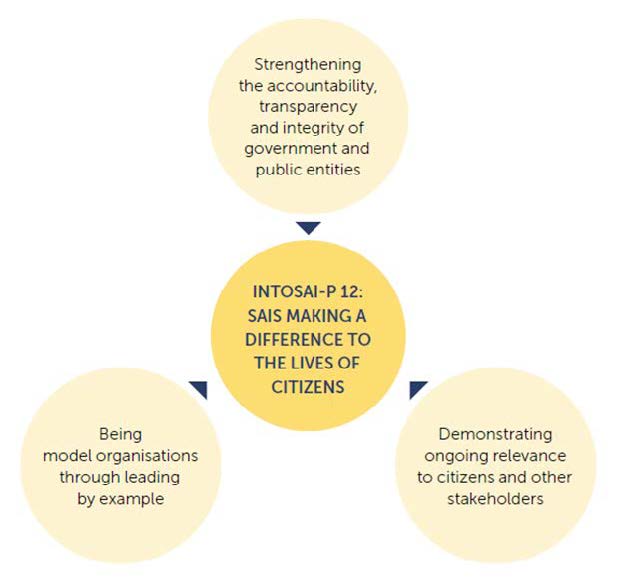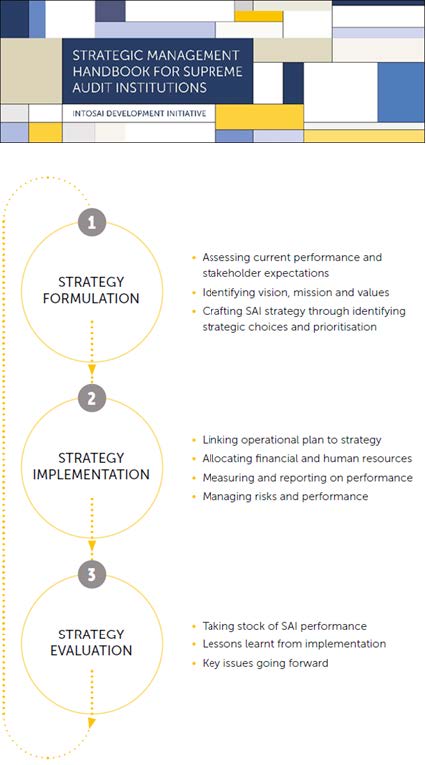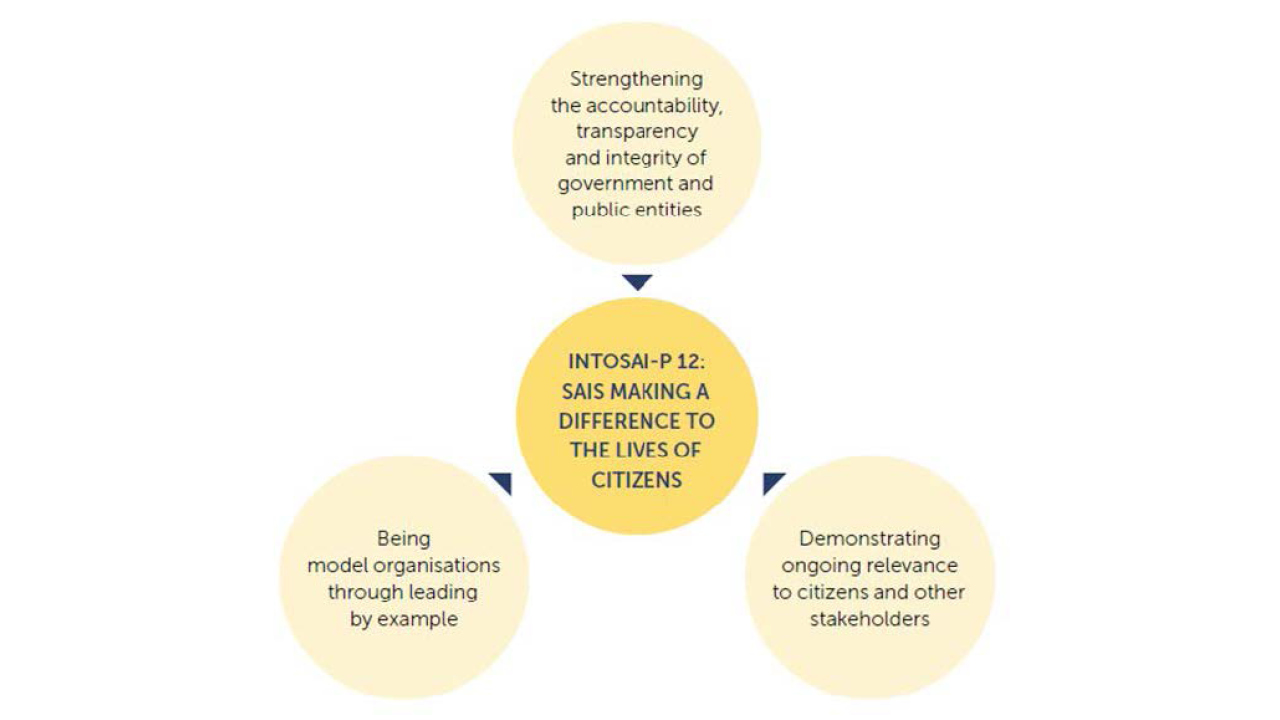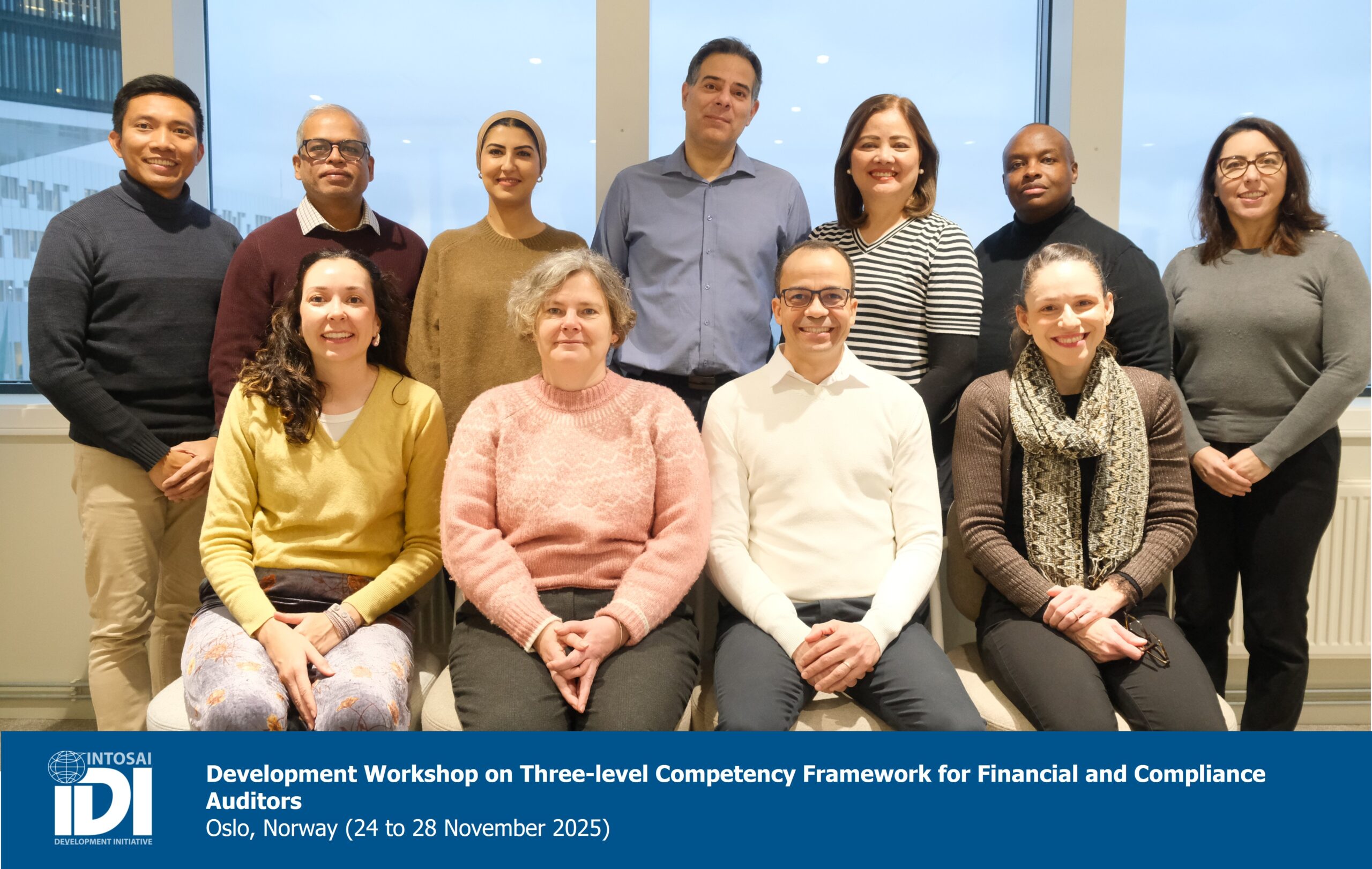Developing a long-term strategic plan is a demanding undertaking for any organisation and public audit institutions are no exception.
By By Dafina Dimitrova and Nils Vösgen, INTOSAI Development Initiative
Developing a long-term strategic plan is a demanding undertaking for any organisation and public audit institutions are no exception. The INTOSAI Development Initiative (IDI), which belongs to the INTOSAI global umbrella organisation of supreme audit institutions (SAIs), tries to provide guidance and capacity development to SAIs all over the world. Dafina Dimitrova is Senior Manager in the SAI Governance Department of IDI and Nils Vösgen is Manager in the same department. Below they provide insights into how their organisation tries to help SAIs with strategic development and management in a versatile audit environment, including by using the recently published SAI Strategic Management Handbook.
A new perspective on strategic planning and management
A strategic plan is one of the most powerful tools supreme audit institutions (SAIs) can use in the quest to enhance their performance in an increasingly complex and uncertain world and to influence the quality of public sector governance and service delivery for the benefit of all. Even more, a strategic plan, paired with robust management and decision-making processes, helps SAIs to deliver their mandate more effectively and to enable them to become the model institutions they aspire to be.
SAIs have been preparing strategic plans for a long time. In line with its mandate to support SAIs in developing countries, the INTOSAI Development Initiative (IDI), as an autonomous implementing body of the International Organisation of Supreme Audit Institutions (see Box 1), has been assisting SAIs in the strategic planning area since as early as 2009. Traditionally, SAI strategic plans have mostly targeted improvements in audit practices and internal processes. Over the last decade, however, SAIs’ understanding of a strategic plan’s role and scope, and with it, the IDI’s support, have gradually evolved. The narrower strategic planning focus has expanded towards a more comprehensive and externally oriented strategic management approach.
 Box 1 – the INTOSAI Development Initiative (IDI)
Box 1 – the INTOSAI Development Initiative (IDI)
IDI is a not-for profit, autonomous implementing body, mandated to support SAIs in developing countries to sustainably enhance their performance and capacity.
With a needs-based approach, IDI seeks to empower SAIs by peer-to-peer cooperation. Activities range from reporting and advising on SAI’s independence, promoting SAI governance (for example through the SAI Performance Measurement Framework), Peer-support Partnerships, professional education for SAI auditors, support in auditing SDGs, or launching
Several important innovations in the international community of SAIs lie at the heart of this transformation. First, in 2010, the INTOSAI community adopted the International Standards for Supreme Audit Institutions (ISSAIs), which provided a common foundation for the work of SAIs worldwide. Linked to the adoption of the ISSAIs, a second impetus for the change in the understanding of and approach to strategy development happened in 2016, when INTOSAI endorsed the SAI Performance Measurement Framework (SAI PMF). The SAI PMF offered a globally accepted framework for measuring SAI performance holistically and objectively against the ISSAIs and other good practices. For many SAIs, SAI PMF reports have served as a starting point for developing their strategies.
In parallel, one of the core INTOSAI principles for SAIs, INTOSAI P-12, on the value and benefits of SAIs, was endorsed in 2013. INTOSAI P-12 (see Figure 1) called for SAIs to make a difference in citizens’ lives not just by contributing to public sector transparency, accountability and integrity. It put the onus on SAIs to become more responsive and relevant to their public sector environment and to act as model organisations of good governance.
Figure 1 – INTOSAI P-12

To respond to these developments and better support SAIs in preparing and implementing strategic plans in line with INTOSAI P-12 expectations, the IDI developed the SAI Strategic Management Framework (SSMF). The SSMF is closely aligned to SAI PMF but provides a forward-looking perspective to aide SAIs in strategic planning and management (see Figure 2).
Figure 2 – SAI Strategic Management Framework

Source: IDI
The SSMF functions as a high-level results framework that defines a hierarchical chain of performance improvements that SAIs must address to effect change. The SSMF clarifies that internal capacity developments, such as improvements in human resources or audit methodologies, systems and processes, need to lead to tangible positive changes in external audit quality and other core work. But the SSMF does not stop there. It emphasises the need to frame, measure and report on SAI performance, as manifested in the quality, coverage and timeliness of its audits and other core work, in relation to its contribution to more robust public sector governance, implementation of United Nations Sustainable Development Goals (SDGs), and ultimately to better lives of citizens.
A handbook on Strategic Management for SAIs
As part of its capacity development support to SAIs, the IDI released its strategic planning book for SAIs in 2009. SAIs from both developing and developed countries widely applied the handbook as a blueprint for strategic planning. However, the 2009 guide did not fully respond to the changing need of SAIs to consider a broader and more externally oriented strategic management approach as captured by INTOSAI P-12. Neither did it capture the logic of the SSMF.
Data on SAI achievements and outstanding needs in the strategic management area confirmed that the guidance needed updating. According to the 2017 Global SAI Stocktaking Report, the share of SAIs worldwide with a strategic plan increased from 73 % to 91 % between 2010 and 2017. Most of those SAIs also had annual operational plans in place. However, a significant share of SAIs did not link the two; neither had they linked their strategic priorities to resource allocation. 61 % of respondent SAIs in 2017 said that they only monitored the implementation of their strategies at activity level and not at the level of improved performance. In conclusion, the global SAI community was lagging behind its good governance aspirations as laid down in INTOSAI-P-12 on several counts.
To respond to these challenges, the IDI completely overhauled and expanded its strategic planning handbook. The new SAI Strategic Management Handbook was published in late 2020, after an extensive development and public exposure phase. The handbook presents a holistic strategic management approach, based on the SSMF. It covers in detail all stages of the process, from assessment, through strategic and operational planning, to monitoring, implementation and reporting (see Figure 3).
Figure 3 – SAI Strategic Management handbook

The methodology emphasises inclusiveness when developing the strategy in line with the INTOSAI P-12 objective of SAIs being responsive to their environment. It recommends a stakeholder analysis to supplement the objective SAI PMF assessment. Through it, SAIs can identify those results and needs that matter for their stakeholders and strengthen both internal ownership and external buy-in from those stakeholders critical to the SAI’s performance.
The new handbook also goes in-depth into the link between strategy and implementation. It focuses on operational plans as a critical strategic management tool and emphasises the need for prudent resourcing at the strategic and operational levels. Other novel elements of the methodology are a focus on prioritisation in light of factors such as available resources, potential impact or legality, and an integrated approach to measurement and monitoring of performance and risks at strategic and operational levels. Finally, it supports SAIs in their strategy implementation with guidance on decision-making and change management.
While the IDI’s mandate is, in principle, to support developing-country SAIs, the handbook’s approach is versatile. SAIs from both developing and developed countries can apply it, irrespective of their institutional set-up and model. Each chapter contains practical guidance and examples and distinguishes between basic and more advanced strategic management features. Depending on their current capacities, practices and context, SAIs can decide which elements are most useful. Many SAIs of EU Member States may already be following to a large degree the good practices described. Still, they can use the handbook to confirm their processes’ quality and identify outstanding improvement areas.
Supporting strategy development in testing times
The SAI Strategic Management Handbook was prepared in the framework of IDI’s Strategy, Performance Measurement and Reporting (SPMR) capacity development initiative. SPMR supports SAIs through the whole cycle of strategic management, from conducting SAI PMF assessments and engaging with stakeholders to gather their views, through strategy development to set up relevant, operational planning, monitoring, and reporting routines that underpin strategy implementation. The initiative is delivered in regional groups over several years through workshops, individual advice to SAI teams, and online interactions. The regional set-up allows participating SAIs to learn from peers and lend mutual support.
IDI first piloted the SPMR initiative and the methodology that later on fed into the SAI strategic management handbook in the Pacific and Caribbean. The global roll-out of SPMR commenced in 2019, with the financial support of the Swiss State Secretariat for the Economy (SECO). Over 40 SAIs from Europe, Asia, Africa, and Latin America presently participate in the global phase. Among those are several SAIs from developed countries.
It was precisely at the strategy development phase of the SPMR initiative when the global COVID-19 crisis struck. Like all other institutions, SAIs faced a heightened level of uncertainty as the pandemic hit. At first, they had to react to the health threat to their staff and organise short-term functionality. However, the focus quickly reverted to strategy, and as it unfolded, the pandemic drastically changed the outlook and significance of strategy development for the participating SAIs.
SAIs promptly realised that the changed situation provided some crucial opportunities for SAIs. They could strengthen their relevance and image by ensuring effective oversight of unprecedented volumes of emergency spending. Audit work on health and social security systems, disaster relief, crisis management and gender equality in times of crisis received new attention. On the other hand, SAIs also faced significant challenges, with many experiencing reduced budgets, staff shortages, and auditing limitations in non-digitised environments. How to reconcile such challenges with the elevated expectations from SAIs and at the same time deliver on their mandate became the central question SAIs looked to answer through their strategic and operational plans (see also Box 2).
Box 2 – Covid-19 related strategic planning priorities considered by SAIs participating in SPMR
Contribute to the government’s ICT and digitalisation efforts (SAIs of Costa Rica and Malaysia)
Ensure accountability of vaccination procurement and support implementation of disaster risk management across public institutions(SAI of Peru)
Enhance awareness of and trust in the SAI through audits on COVID-related topics such as gender equality, health care or emergency spending (SAIs Botswana and United Arab Emirates)
SPMR provided participating SAIs with the right tools to adapt their strategy development to the new circumstances. With heightened uncertainty, risk management and scenario planning became more integral parts of the approach. Resource estimation and allocation received unprecedented attention. Covid-19 also underscored the importance of regular periodic review of progress, continuous learning and the flexibility to adapt and adjust both strategy and implementation along the way. In particular, such strategic changes need to be rooted in a thorough analysis of the external environment, stakeholder needs and opportunities. SAIs also recognised the communication power of strategic plans as a tool to demonstrate relevance, highlight a shared agenda for influencing positive change and serve as an advocacy platform. Such experiences from strategy development during the onset of Covid-19 greatly informed the SAI Strategic Management Handbook’s final version.1
The future of IDI’s Support for Strategic Management
The Covid-19 crisis is far from over and continues to have long-lasting effects on societies and institutions within them. SAIs are reacting to those changes by re-evaluating the focus of their audit work and factoring emerging issues into their strategies. In many places, the pandemic has given a final push towards the overdue digitisation of SAI processes and the establishment of sound ICT infrastructure and governance processes. The pandemic has also shown that SAIs are susceptible to risks and were not all well prepared to handle crises. Finally, in many ways, Covid-19 has accentuated persisting inequalities, specifically gender inequality, where SAIs are yet to prove that they lead by example.
The various repercussions and implications of Covid-19 also underscore the need for the IDI to plan and provide its support in a holistic and multi-faceted manner. The IDI is launching several new initiatives in the governance area in 2021, closely related to the experiences with strategic planning and management gathered through SPMR and the handbook development. These initiatives will focus on SAI leadership, ICT governance, human resources, ethics and gender, and risk and crisis management for SAIs. The SPMR initiative’s roll-out continues in 2021 and will be open to new entrants. All SAIs are welcome to express interest in participation.
1 IDI also prepared specific guidance on Covid-19 implications for SAI strategic management. https://www.idi.no/covid-19/covid-19-strategic-management
To read more go to: https://www.eca.europa.eu/en/Pages/Journal.aspx




